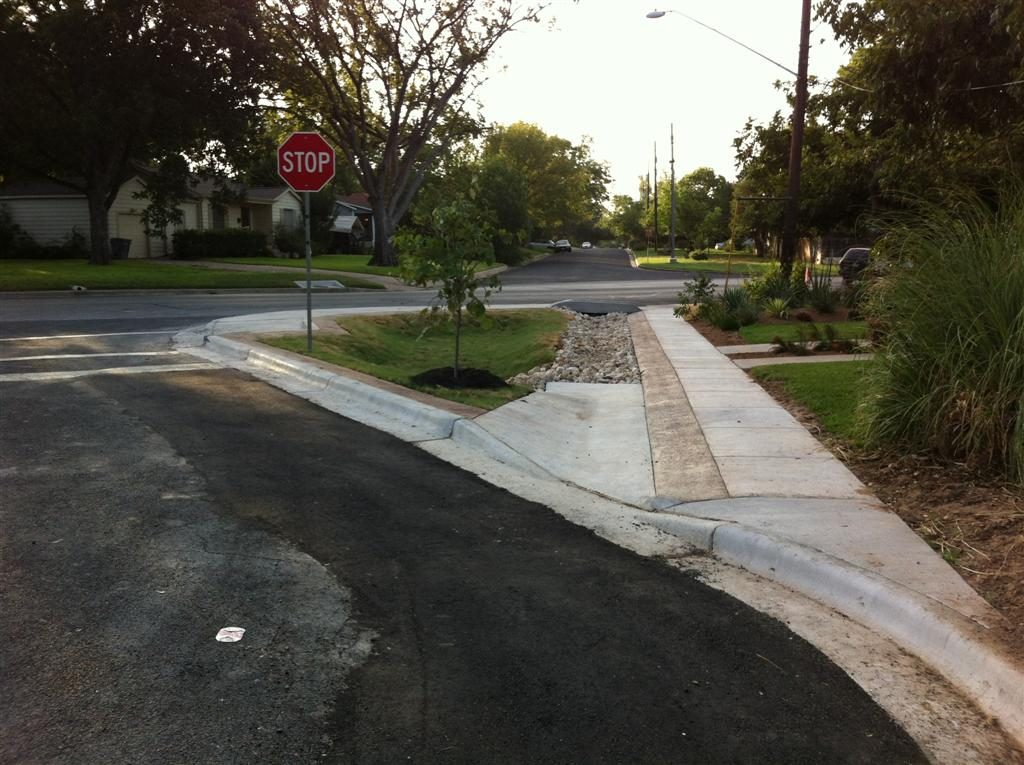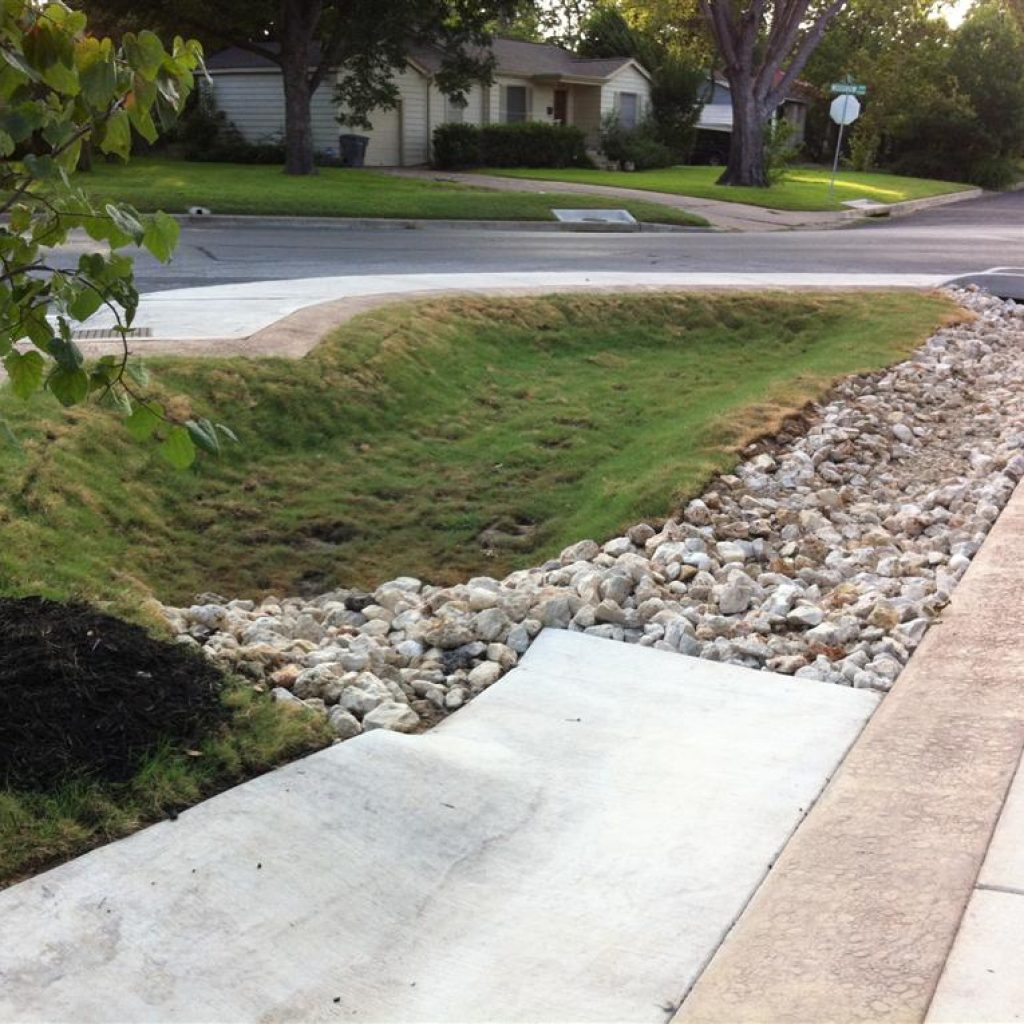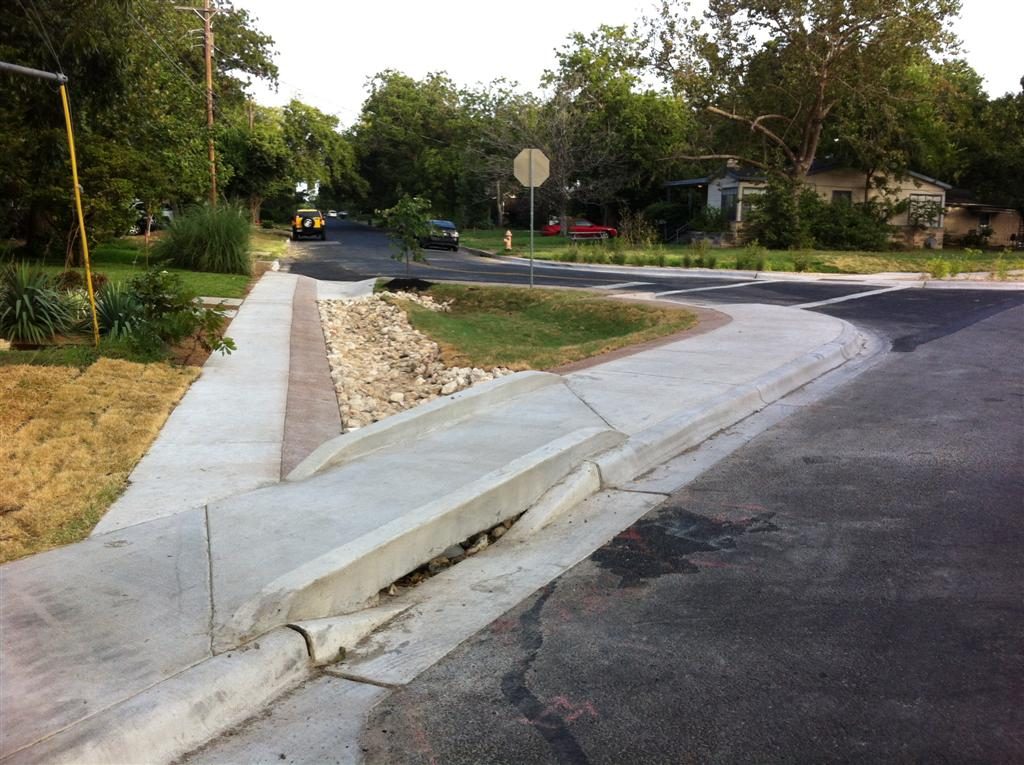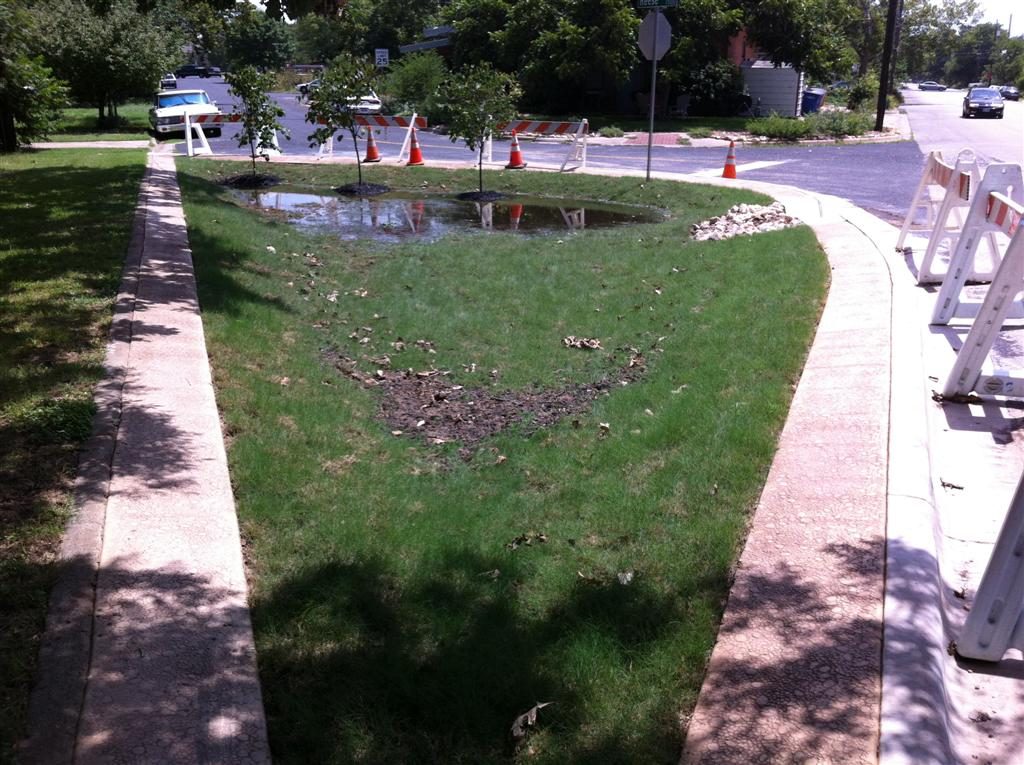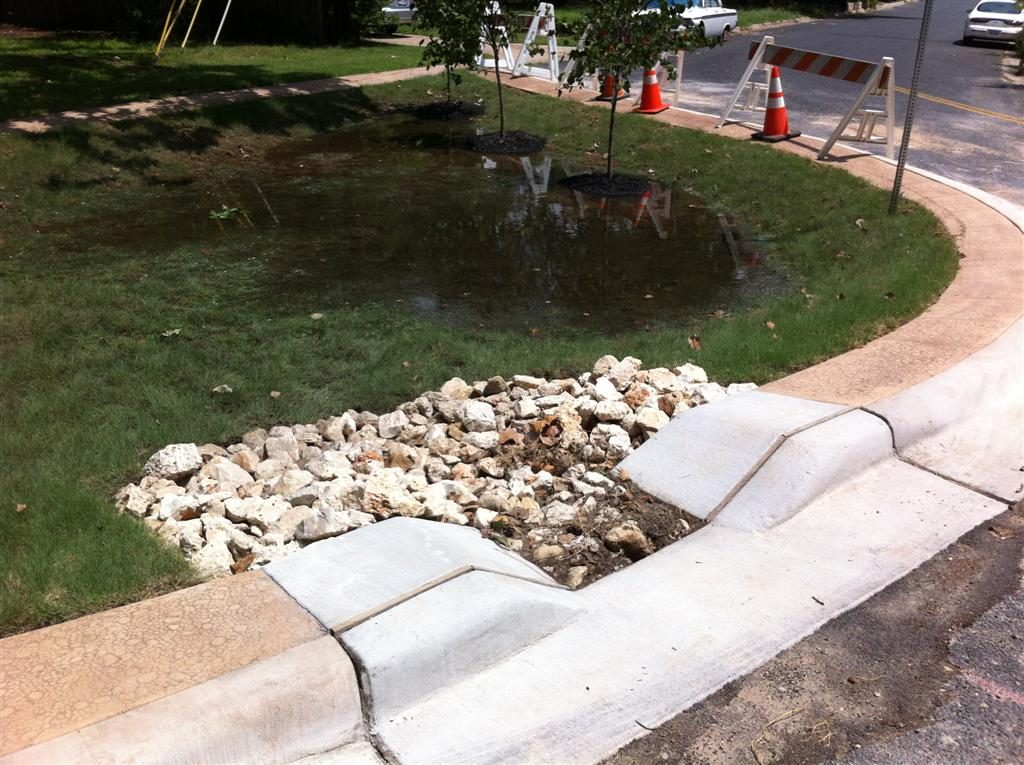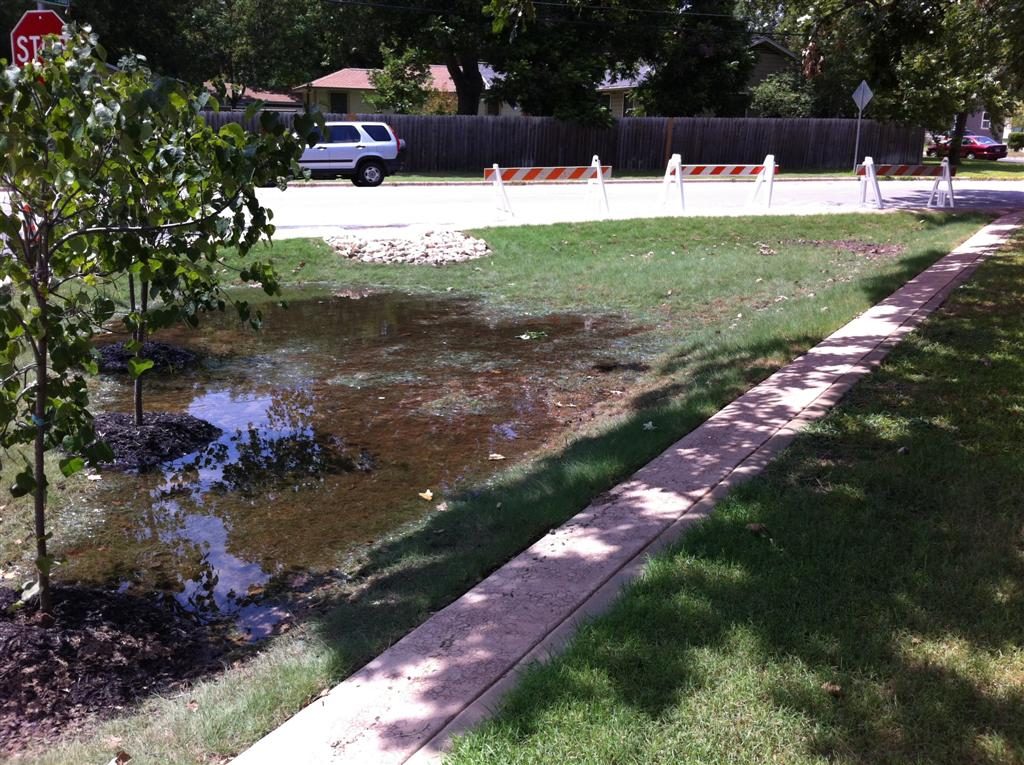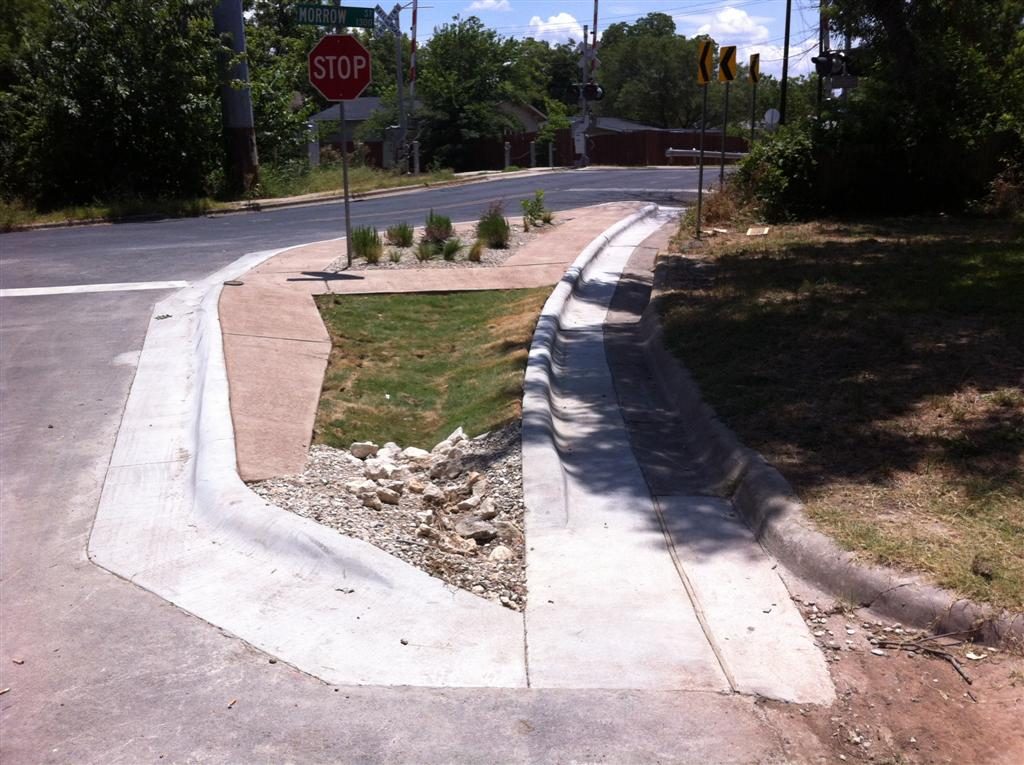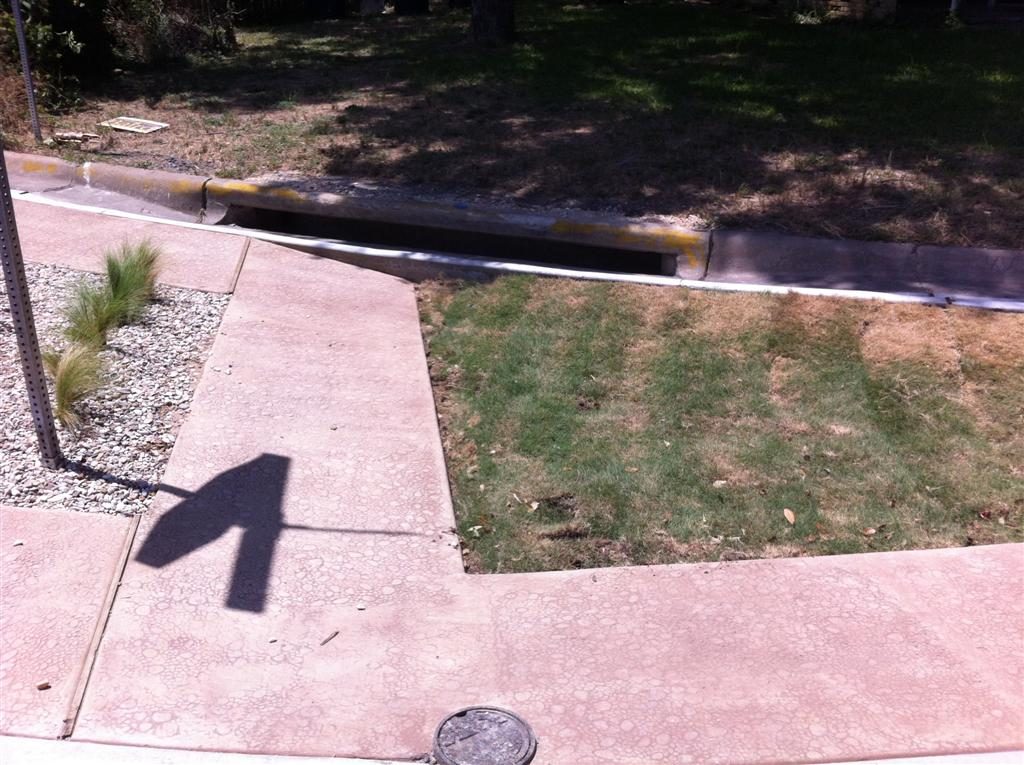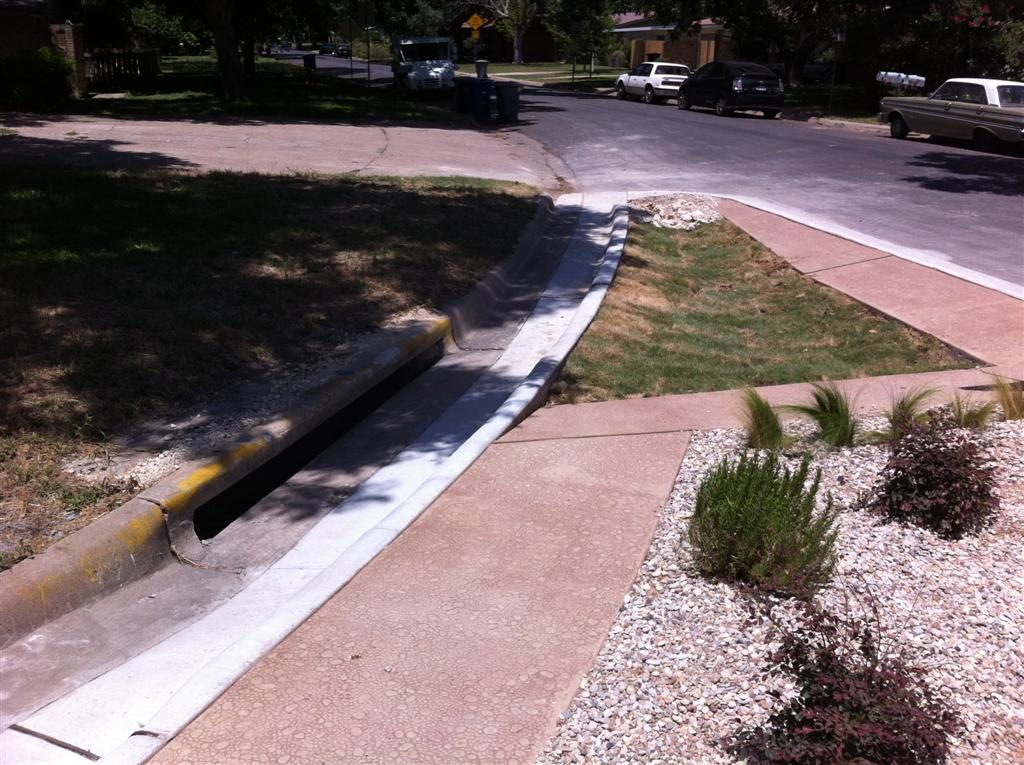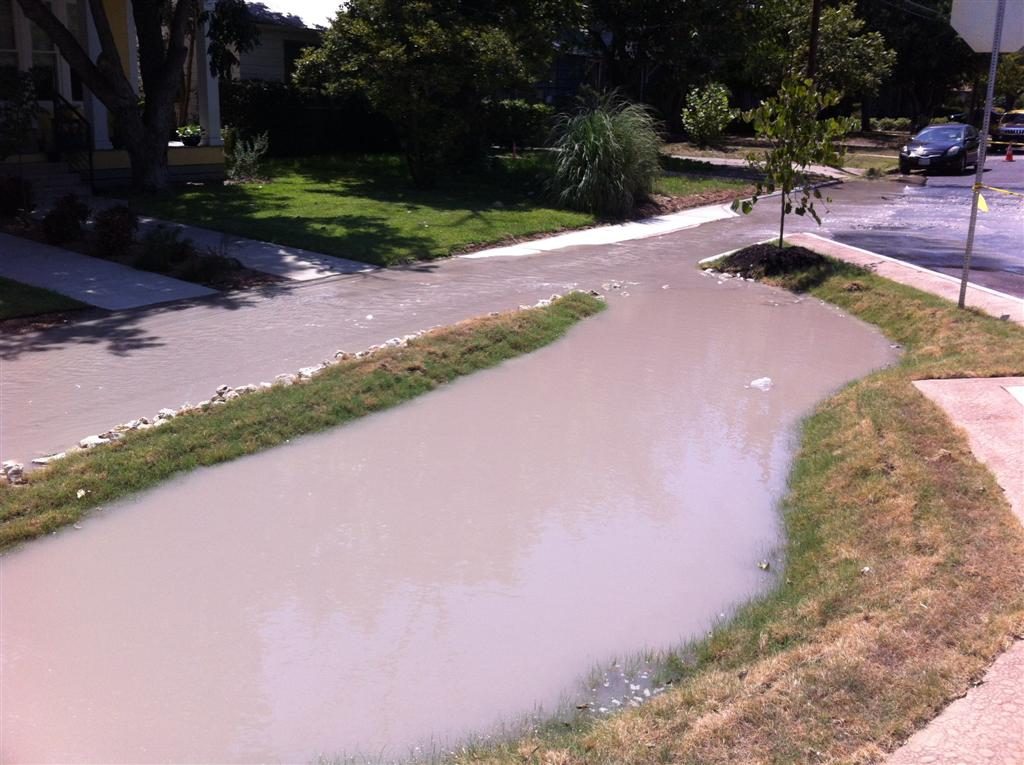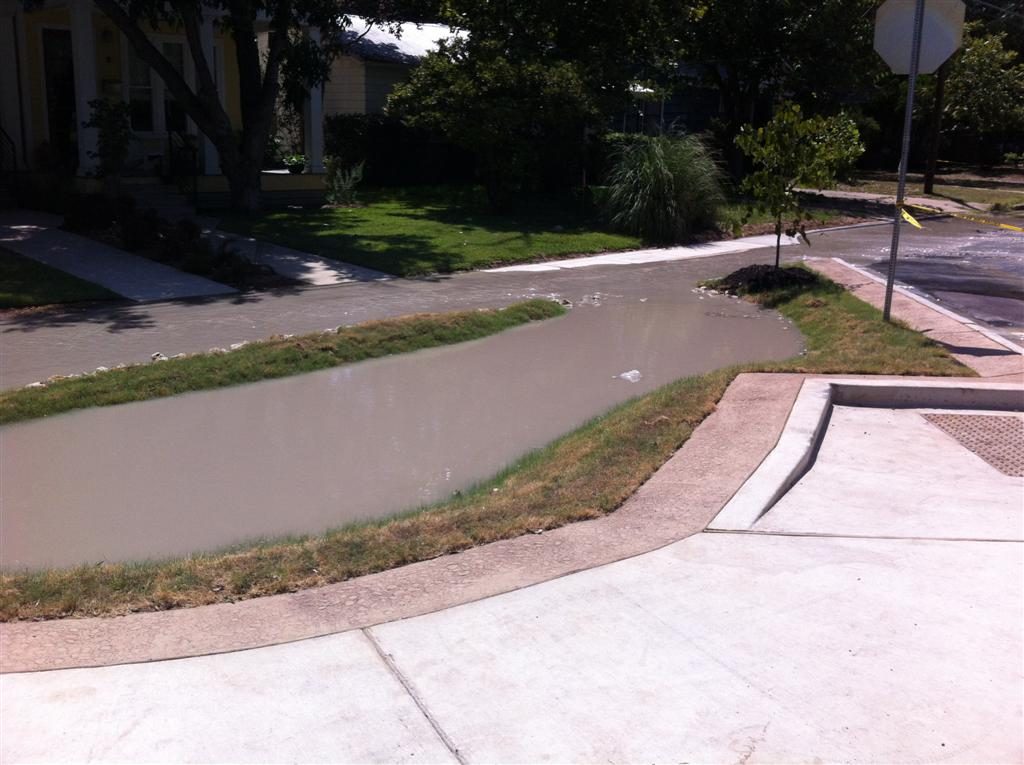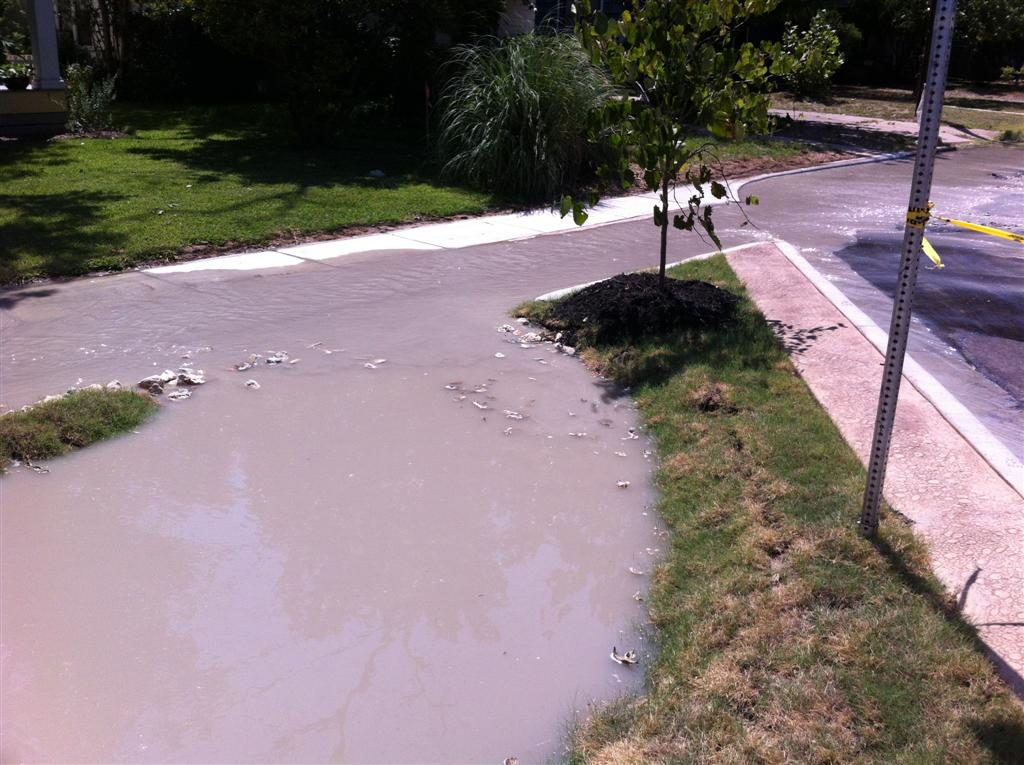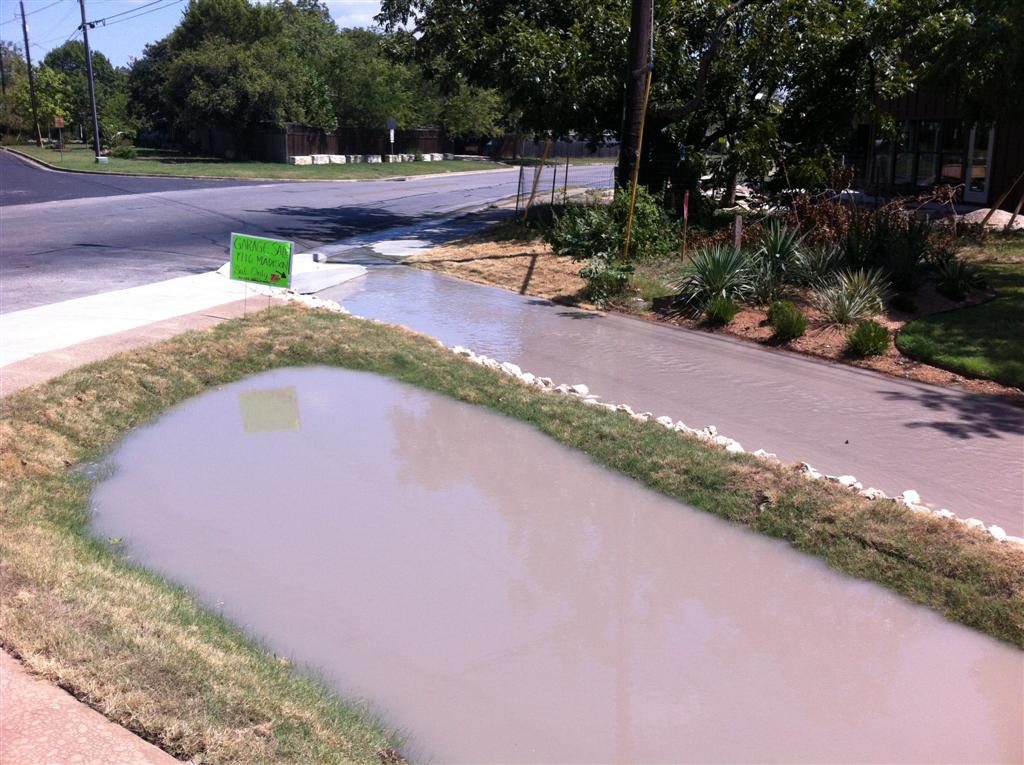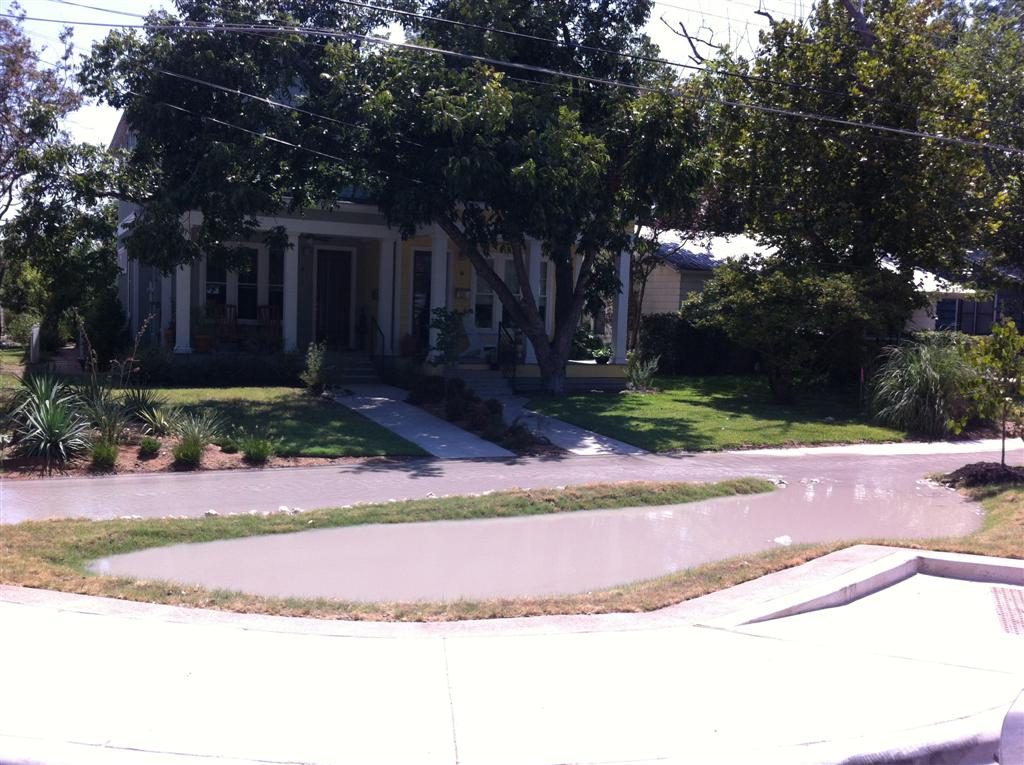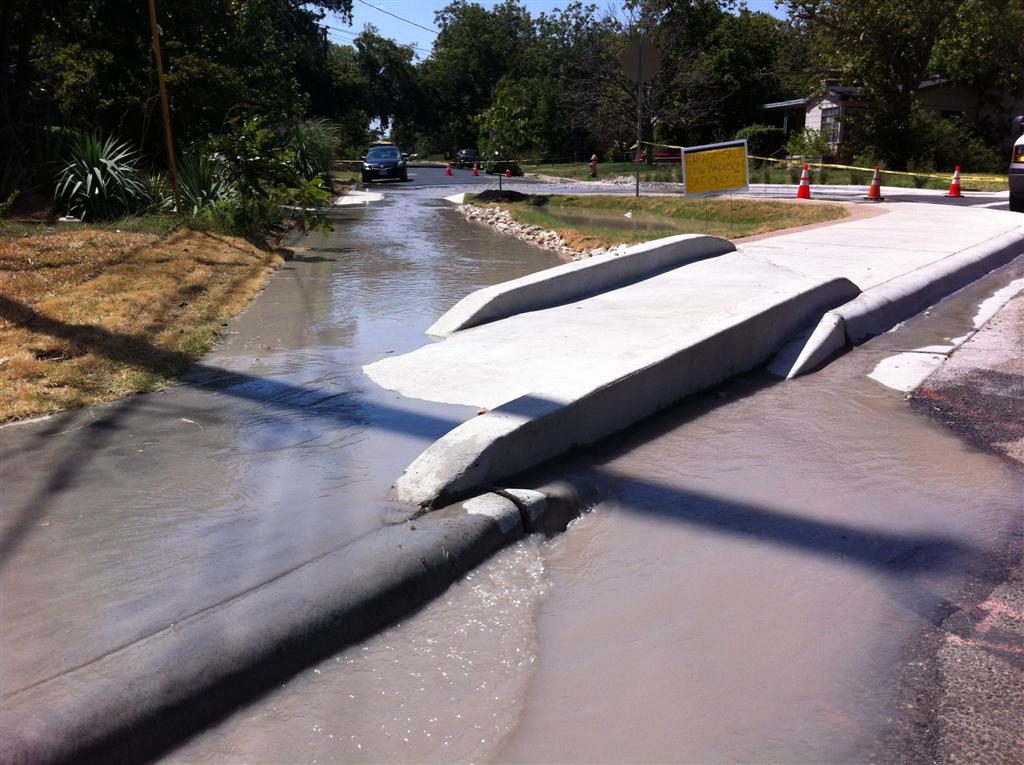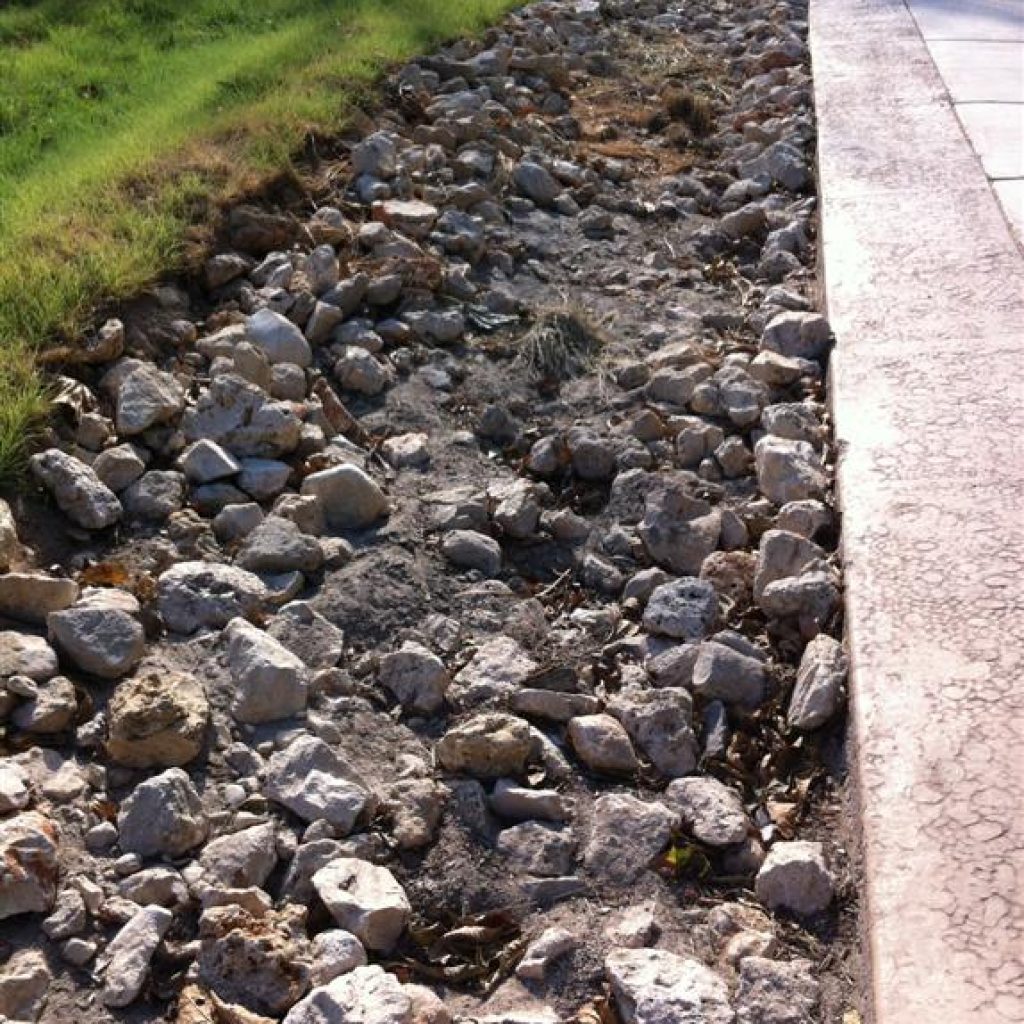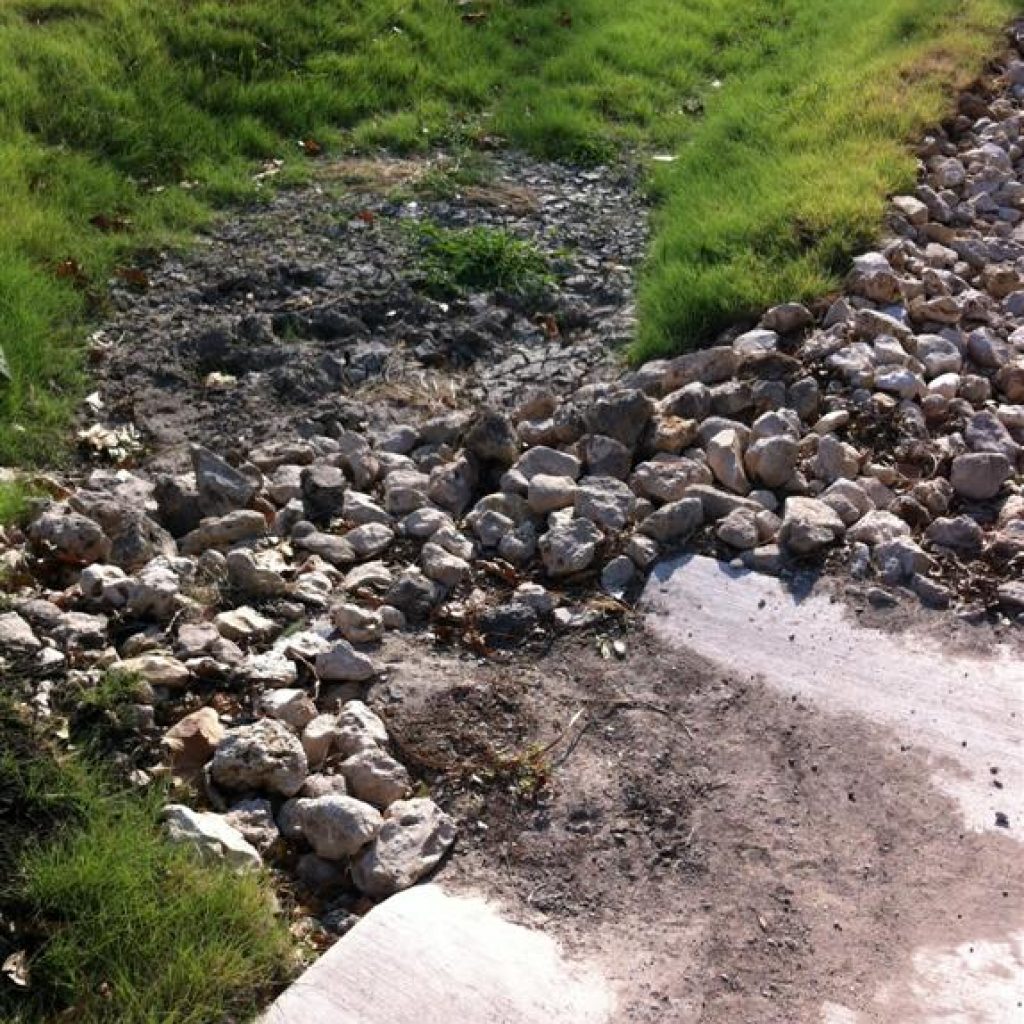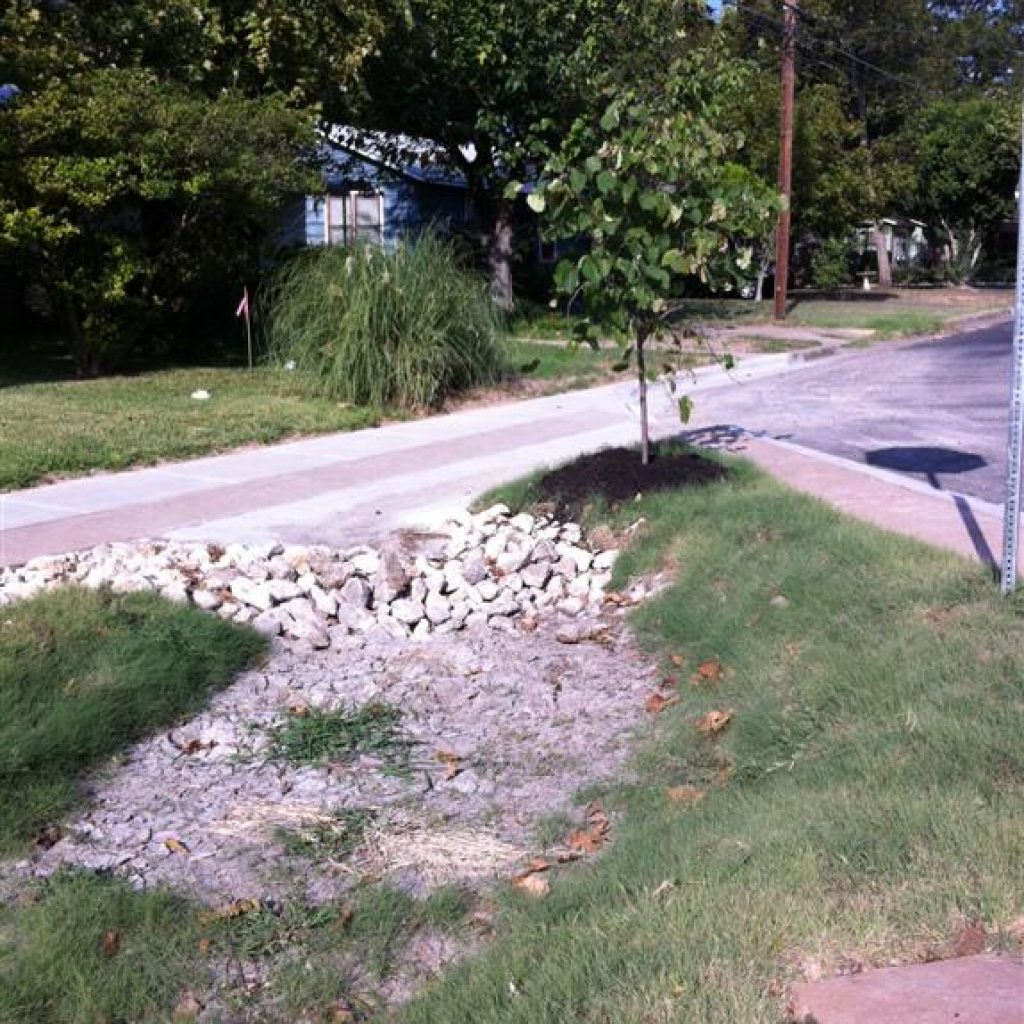I was mighty surprised the other day as I was driving down one of my neighborhood streets in Austin, Texas, to find some new small-scale stormwater infrastructure developments that had recently popped up. I decided to take a bunch of pictures of these new stormwater best management practices (BMPs) and share them with you. Not only did I get some great pictures of three different stormwater BMPs but I also was able to get pictures of one of the BMPs in action (without being in the rain to see it). You will see those pictures later in the post.
Austin’s New Small-Scale Stormwater Infrastructure Examples
I wanted to find out more from the City of Austin about the development of these small-scale stormwater BMPs. Why was the city implementing this new strategy? How did the City pick where to install these BMPs? I was fortunate to interview Michael Kelly, P.E., the Sustainable Stormwater Solutions Manager for the City of Austin Watershed Protection Department. He was very gracious to provide some great information about the City’s new stormwater program.
His interview comes a bit later, but first, some basics…
The Basics of Watershed Protection
Watershed protection is a very important task for any city. Many times, the cities’ drinking water source is the lake or reservoir where all of the stormwater discharges from the city will eventually ends up. Regardless of where the stormwater ends up, it is imperative that cities regulate these flows for pollutants that can be toxic to humans, wildlife, and plants. The EPA, directed by the Clean Water Act, regulates stormwater discharges through the National Pollutant Discharge Elimination System (NPDES) Stormwater Program. It regulates stormwater discharges from three potential sources: municipal separate storm sewer systems (MS4s), construction activities, and industrial activities. In Texas, cities get their authorization from the Texas Commission on Environmental Quality (TCEQ) through their own MS4 program.
So traditionally cities have collected stormwater into stormwater sewer systems and discharged the stormwater runoff into the nearest creek, river, or lake. This type of system was created to prevent damage to city and citizen property due to flooding. Over time, cities have discovered the disadvantages of treating stormwater as purely a nuisance. These include:
- Runoff during extreme storm events cause erosion damage to local streams and rivers
- More impervious cover in urban areas cause high stormwater volume peaks in local streams and rivers during storm events but are followed by extreme low flow since the stormwater wasn’t detained in the watershed for slow release
- Stormwater runoff from impervious surfaces can carry toxic pollutants directly into local streams which can cause many different unwanted scenarios
Green Infrastructure or Low Impact Development
In order to solve the problems created by our traditional stormwater sewer systems, researchers and municipalities have developed a bunch of different BMPs to reduce the problems that arise during large storm events. These BMPs include:
- Stormwater detention/retenion ponds
- Vegetated filter strips
- Biofiltration systems
Typically these BMPs are employed on commercial sites or in new subdivision developments since it is difficult to implement these structures in urban areas that are already developed. These BMPs are designed to reduce the stormwater runoff from a particular site so that the site mimics its pre-developed state in terms of stormwater runoff volume.
Rather than concentrating the stormwater into larger BMPs, a new thought has come forward and has gained a lot of traction of the years… green stormwater infrastructure or low impact development. Basically the new paradigm is to distribute the processing (infiltration) of stormwater throughout our neighborhoods and cities rather than send all of the stormwater straight to our local creeks or rivers or into large-scale BMPs.
The City of Austin’s Green Infrastructure Story
But in 2007, the Austin City Council passed the Green Infrastructure Resolution which directed the City Manager to consult with the Watershed Protection Department regarding innovative site development opportunities.
Then in July 2011, the Watershed Protection Department formalized its commitment to green infrastructure by creating the Green Infrastructure Team. This team is a cross-disciplinary group with members from each of the department’s function units: water quality, stream restoration, flood mitigation, education, maintenance, policy, and planning. The mission of the team is to investigate and maximize the opportunities for green stormwater infrastructure to reduce flooding and erosion, improve water quality, and reduce the use of potable water for landscape irrigation.
The Interview with Michael Kelly
Here are Mr. Kelly’s responses to the questions I posed to him about this new stormwater infrastructure program.
Q: What is the extent of the new infrastructure program? Will citizens see these improvements implemented all over Austin or is the City focusing on certain areas?
The City of Austin’s Green Infrastructure Initiative has four primary areas of focus:
1. City funded stormwater retrofits. Staff identifies watersheds with significant pollution and earmarks money for implementation of treatment devices. These include Green Stormwater Infrastructure (GSI) elements like rain gardens and vegetated filter strips. Watersheds with GSI include: Blunn, Bull, East Bouldin, West Bouldin, Barton, with plans build in Tannehill and Boggy next year. You can find your watershed by simply typing in your address.
2. Traffic calming devices that can be designed as small scale stormwater treatment devices. As the Public Works and Transportation Departments continue to implement geometric roadway improvements designed for pedestrian and bicycle safety, Watershed Protection evaluates these areas for suitability of infiltration rain gardens. The infiltration rate of the subsoil under the street is one of the primary determinants of the suitability of the traffic calming devices for rain gardens. The presence of utilities is usually the other main factor.
3. Design guidance for private developments to use GSI to comply with Water Quality ordinances. Section 1.6.7 of the City of Austin Environmental Criteria Manual focuses on GSI (listed under Innovative Controls section).
4. Education/outreach programs aimed at homeowners and AISD campuses to voluntarily install GSI (mostly rain gardens) on site.
Q: How did the locations for this improvements get chosen?
Monitoring staff compiled an Environmental Integrity Index that ranked the creeks in Austin from most polluted to least polluted. Watersheds with highest pollution scores are targeted for stormwater retrofits.
Q: Why is the City implementing this type of stormwater infrastructure versus investing in larger scale stormwater infrastructure?
The City is supplementing traditional grey infrastructure (pipes, ponds) with GSI. It is another tool in the tool box, to be used where aesthetics demand a more landscaped approach or where traditional structures may not be cost effective.
Q: Were there certain storm event sizes that the new infrastructure improvements were designed for?
For City sponsored GSI retrofits, we capture as much volume as the site allows. Most GSI projects strive to capture the first inch of runoff, but usually we are fortunate to be able to capture the first half inch of runoff.
Q: Did the City engage in an educational program for the citizens so that the citizens understand the point behind these improvements?
The City has provided some examples of education outreach designed for homeowners.
Q: I can see many citizens calling the City, asking about these improvements with “little ponds”. Does the City have a special hotline or process for responding to this inquiries?
Nothing explicit for handling GSI enquiries. The requests for information usually come to me.
Q: Is the City collecting data from these improvements to see how they function? If so, how is the City collecting this data and is there a certain success goal for these improvements?
We are monitoring the flow and chemical constituents for two rain gardens and two biofiltration ponds. The primary goal is to verify the calculations made regarding how much water can infiltrate into the ground and then the chemical goals are to replicate the lab tests obtained from a joint study with UT on the performance of biofiltration systems.
Thanks again to Mr. Kelly for taking the time to answer some questions about the program.
Here is a link to a Green Stormwater Infrastructure presentation which further explains the program for the City of Austin.
Stormwater BMP in Action
I happened to be driving by one of the BMPs and there just happened to be a water main break just upstream from the BMP. The water main break was a shame due to all the water lost but it did allow me to see the BMP in action. Normally you would have to be out in the rain to capture pictures like this so I got very lucky.
Stormwater BMP After the Storm
Some time after some recent storm events, I wanted to see how the BMPs were affected. All stormwater BMP require routine maintenance. For example, detention ponds or filtration ponds will need routine dredging since eroded soil materials brought into the system by the stormwater will accumulate to a point that the system will become clogged or lose detention volume. I suspected that these smaller BMPs would require maintenance and wondered if the city has a maintenance plan in place for all of these smaller BMPs scattered throughout the city. The maintenance may be more difficult to manage over large scale BMPs but I believe these smaller BMPs are better for our waterways and communities.
You can see some of what I am talking about in the pictures below. You can see the sediment that was brought in by the stormwater, beginning to fill the void spaces in the large aggregate and also beginning to accumulate in the basin.
If you are still with me here, I would love any thoughts and comments about small-scale stormwater BMPs. Do you think they are worth the effort for a large municipality to implement? What are some of the positives and negatives of these systems that I might have missed? Do you have any other questions for Mr. Kelly about Austin’s green stormwater initiative?
Image attribution: ©Innovative Water Solutions LLC


